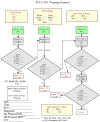Inhaled nitric oxide and related therapies
- PMID: 20216160
- PMCID: PMC2844851
- DOI: 10.1097/PCC.0b013e3181c76b42
Inhaled nitric oxide and related therapies
Abstract
Children with congenital heart defects are at risk for perioperative pulmonary hypertension if they require corrective or palliative surgery in the first week of life or if they have defects associated with significant pulmonary overcirculation. In addition, children undergoing cavopulmonary connections for single ventricle lesions require low pulmonary vascular resistance for surgical success. Treatment of perioperative pulmonary hypertension with inhaled nitric oxide has become standard therapy in many centers. Related drugs that increase nitric oxide synthesis, including arginine and citrulline, have also been studied in the perioperative period. In this article, previous clinical trials of inhaled nitric oxide, intravenous arginine, and intravenous and oral citrulline in children with perioperative pulmonary hypertension or elevated pulmonary vascular resistance after a cavopulmonary connection are reviewed. In addition, recommendations are presented for each agent on the clinical use in the perioperative setting including clinical indications, assessment of clinical effect, and length of therapy.
Figures



Similar articles
-
Postoperative Inhaled Nitric Oxide Does Not Decrease Length of Stay in Pediatric Cardiac Surgery Admissions.Pediatr Cardiol. 2019 Dec;40(8):1559-1568. doi: 10.1007/s00246-019-02187-z. Epub 2019 Aug 24. Pediatr Cardiol. 2019. PMID: 31446473
-
Use of sildenafil to facilitate weaning from inhaled nitric oxide in children with pulmonary hypertension following surgery for congenital heart disease.J Intensive Care Med. 2008 Sep-Oct;23(5):329-34. doi: 10.1177/0885066608321389. Epub 2008 Aug 12. J Intensive Care Med. 2008. PMID: 18701525
-
Acute pulmonary hypertension in infants and children: cGMP-related drugs.Pediatr Crit Care Med. 2010 Mar;11(2 Suppl):S37-40. doi: 10.1097/PCC.0b013e3181c8e6e9. Pediatr Crit Care Med. 2010. PMID: 20216161 Review.
-
Variable response to inhaled nitric oxide in postoperative patients of mitral stenosis with pulmonary hypertension.J Ayub Med Coll Abbottabad. 2009 Jan-Mar;21(1):98-102. J Ayub Med Coll Abbottabad. 2009. PMID: 20364753
-
Review of inhaled nitric oxide in the pediatric cardiac surgery setting.Pediatr Cardiol. 2012 Apr;33(4):493-505. doi: 10.1007/s00246-012-0172-4. Pediatr Cardiol. 2012. PMID: 22298229 Review.
Cited by
-
Plasma asymmetric dimethylarginine levels are increased in neonates with bronchopulmonary dysplasia-associated pulmonary hypertension.J Pediatr. 2015 Feb;166(2):230-3. doi: 10.1016/j.jpeds.2014.09.004. Epub 2014 Oct 11. J Pediatr. 2015. PMID: 25311706 Free PMC article.
-
Pediatric Perioperative Pulmonary Arterial Hypertension: A Case-Based Primer.Children (Basel). 2017 Oct 24;4(10):92. doi: 10.3390/children4100092. Children (Basel). 2017. PMID: 29064445 Free PMC article. Review.
-
Postoperative Inhaled Nitric Oxide Does Not Decrease Length of Stay in Pediatric Cardiac Surgery Admissions.Pediatr Cardiol. 2019 Dec;40(8):1559-1568. doi: 10.1007/s00246-019-02187-z. Epub 2019 Aug 24. Pediatr Cardiol. 2019. PMID: 31446473
-
Surgery for partial atrioventricular septal defect with pulmonary hypertension in an adult dog.J Vet Med Sci. 2018 Jul 18;80(7):1183-1189. doi: 10.1292/jvms.17-0509. Epub 2018 Jun 6. J Vet Med Sci. 2018. PMID: 29877312 Free PMC article.
-
Arginine de novo and nitric oxide production in disease states.Am J Physiol Endocrinol Metab. 2012 Nov 15;303(10):E1177-89. doi: 10.1152/ajpendo.00284.2012. Epub 2012 Sep 25. Am J Physiol Endocrinol Metab. 2012. PMID: 23011059 Free PMC article. Review.
References
-
- Macrae DJ, et al. Inhaled nitric oxide therapy in neonates and children: reaching a European consensus. Intensive Care Med. 2004;30(3):372–80. - PubMed
-
- Wessel DL, Adatia I, Giglia TM, Thompson JE, Kulik TJ. Use of inhaled nitric oxide and acetylcholine in the evaluation of pulmonary hypertension and endothelial function after cardiopulmonary bypass. Circulation. 1993;88:2128–2138. - PubMed
-
- Miller OI, et al. Very-low-dose inhaled nitric oxide: A selective pulmonary vasodilator after operations for congenital heart disease. J Thorac Cardiovasc Surg. 1994;108(3):487–494. - PubMed
-
- Curran RD, Mavroudis C, Backer CL, Sautel M, Zales VR, Wessel DL. Inhaled Nitric Oxide for Children With Congenital Heart Disease and Pulmonary Hypertension. Ann Thorac Surg. 1995;60:1765–71. - PubMed
-
- Russell IAM, Zwass MS, Fineman JR, Balea M, Rouine-Rapp K, Brook M, Hanley FL, Silverman Norman H, Cahalan MK. The Effects of Inhaled Nitric Oxide on Postoperative Pulmonary Hypertension in Infants and Children Undergoing Surgical Repair of Congenital Heart Disease. Anesth Analg. 1998;87:46–51. - PubMed
Publication types
MeSH terms
Substances
Grants and funding
LinkOut - more resources
Full Text Sources
Medical

